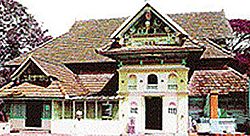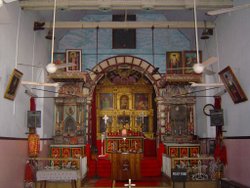- Ethnic groups in Kerala
-
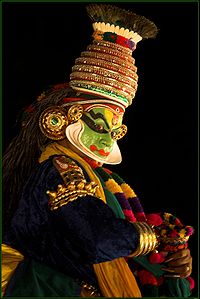 Kathakali is popular art form in Kerala
Kathakali is popular art form in Kerala
This article gives an overview of the ethnic groups in Kerala, with links to articles that provide more detail. A coastal state, the Malayali people of the Indian state of Kerala have been in contact with Jewish, Syrian and Arab traders and missionaries for over two thousand years. Descendants of these people now speak Malayalam, the language of the great majority of people Kerala, but retain distinctive cultural and religious traditions. Various ethnic groups with origins in other parts of India have unique customs and use languages at home other than Malayalam, adding to the rich cultural diversity of the state.[1][2]
Contents
Malayali
Main article: MalayaliThe native people of Kerala who speak Malayalam, the official language of the state is called Malayali (Malayalam: മലയാളി). The Malayalam language is a Dravidian language closely related to Tamil which crystallized into a distinctive tongue only at the beginning of the medieval era. Modern Malayalam includes loan words from Portuguese, Arabic, Syriac, and in more recent times English.[3] While the majority of Malayalis live in Kerala, significant populations also exist in other parts of India, the Middle East, Europe and North America. According to the Indian census of 1991, there were 28,096,376 speakers of Malayalam in Kerala, making up 96.66% of the total population of that state. The slang Mallu is sometimes used by the media and North Indians to refer to a Malayali in informal contexts.[4]
The majority (about 54%) of the Malayali people are Hindu, mostly of the Ezhava and Nair communities, but there are also large Muslim (24%) and Christian (18%) communities.[5] The Muslim community, or Mappilas, trace their origins far back to early contacts with Arab traders before the start of the Christian era, and mostly follow the Shafi`i school of Sunni Islam. Many speak the distinctive Mappila dialect of Malayalam.[6] Many of the Christians belong to the Syrian Malabar Nasrani community, and are also known as the Nasrani Mapilas.[7] Some of the Christians, known as the Knanaya, trace their origins to Jewish immigrants.[8] The descendants of the Cochin Jews who have traditionally followed Halakhic Judaism are known as Juda Mappila.[9]
Tamil
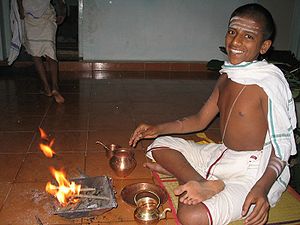 Tamil Brahmin boy performing Yajna according to Vedic traditions
Tamil Brahmin boy performing Yajna according to Vedic traditions Main article: Kerala Iyers
Main article: Kerala IyersSince time immemorial, there have been frequent migrations to Kerala from the neighbouring state of Tamil Nadu. The history of ancient Kerala itself is deeply intertwined with Tamil Nadu's ancient past, and the Tamil and Malayalam languages are closely related. The dialect of Tamil spoken today in the district of Palakkad in Kerala has a large number of Malayalam loanwords, has been influenced by Malayalam syntax and also has a distinct Malayalam accent.[10]
Some of the earliest migrations attested by history were those of Iyers from the Cauvery delta to the district of Palakkad. The first of these migrations are believed to have taken place over five hundred years ago. These Iyers settled in Palakkad where they owned land and led an affluent existence till the enactment of the land reforms in the 1960s. They followed many Malayali practices include the practice of sambandham. There have also been migrations of Iyers to the princely state of Travancore from the Tirunelveli district during the 18th and 19th centuries. These Iyers are called Kerala Iyers and differ significantly from Palakkad Iyers in their language and social status. Most of Travancore's diwans were Tamil Brahmins.[11][12]
Apart from Iyers, many other Tamil communities also migrated to Kerala between the 18th and the 20th century when the southernmost Kanyakumari district of Tamil Nadu was a part of the Travancore kingdom. The capital of the Travancore kingdom which ruled over most of Kerala was located in Padmanabhapuram in present-day Tamil Nadu. The caste system in Kerala is very similar to that which exists in the southern districts of Tamil Nadu.[13]
Vellalars migrated from Tamil Nadu to eastern parts of Kerala like Idukki district, Pathanamthitta District. They are prominently found in Erattupetta, Pala, Ponkunnam, Kanjirappalli, Thodupuzha, Pathanamthitta etc. Similarly, Tamil Muslims migrated the same route from Madurai to Thodupuzha, Irattupetta, Pathanamthitta regions. They are distinct from Malayalam speaking Mappila Muslims in many ways including the usage of a dialect of Tamil inside their houses.
Tulu
Main article: Shivalli Tulu Brahmins of KeralaShivalli Brahmins living all over the Indian state of Kerala are part of the larger Tulu Brahmin subsect primarily found in the Indian state of Karnataka but also in the Kasaragod district of Northern Kerala. Their mother tongue is the Dravidian Tulu language. Brahmins from Tulunadu may have migrated to Kerala before the first century C.E.[14] Today, there is a sizeable Tulu Brahmin population in Thiruvananthapuram and elsewhere in the state.[15]
Kannada
Main article: KannadaKannada is one of the major Dravidian languages of India, spoken predominantly in the state of Karnataka. Kannadigas (ಕನ್ನಡಿಗರು Kannadigaru), number roughly 50 million, making it the 15 most spoken language in the world.[16] It is one of the official languages of India and the official and administrative language of the state of Karnataka.[17]
There are about 3,25,571 speakers of Kannada in Kerala, mainly concentrated in the Kasaragod district of the north. Most Kannada-speakers in Kerala are Tulu people who use Kannada language as an additional tongue.
Konkanis
Cochin GSB's are a branch of the Konkani language speaking Gaud Saraswat Brahmins community of India who form the majority of Konkanis is Kerala. GSBs of Cochin form the southernmost subsect of Saraswat Brahmins of West coast. GSBs of north Kerala are similar to GSBs of Canara in speech and customs, whereas GSBs of former princely states of Cochin and Travancore have developed their own Konkani dialect and Customs, which distinguish them from rest of GSB community, this subsect is now called Cochin GSBs. In Geographical terms, Cochin GSBs are those who live south of Thrissur district of Kerala.[18] Other Konkani speaking Minirities in Kerala include the Kudumbis, Daivajnas,and the Vaishya Vanis.All these groups had migrated from Goa within last few centuries for various soci-economic reasons.
See also: Cochin GSB'sMarathi
See also: T. Madhava Rao and K. Krishnaswamy RaoMarathi is the oldest of the regional literatures in Indo-Aryan languages, dating from about 1000 AD.[19]
There are about 30,000 speakers of the Marathi language (मराठी Marāṭhī) in Kerala. Most Marathi-speakers in Kerala were descendants of administrators and civil servants who migrated from Tamil Nadu's Tanjore district during the 19th century.
Smaller minority groups
Gujaratis
Main article: Cochin GujaratisThere are about 500 Gujarati families living for many generations in Kochi, the commercial hub of Kerala. Gujarati community is composed of various social groups like Jains, Saurashtris and Kutchis in the Indian state. The Gujarati Street at Mattanchery in the city is a main Gujarati cultural icon in Kerala.[20] Calicut also has a sizeable population of Hindu and Jain Guajaratis.[21] They are basically business people doing all forms of wholesale and retail trade. There is a Gujarati Higher Secondary School near Calicut Beach.[22]
Sikhs
Main article: Cochin SikhsKochi is home to the Punjabi speaking Sikh community in Kerala as the coastal city has the most number of Sikhs in the south Indian state. Many of the Kerala's Punjabi Sikh community are in the automobile spare parts industry. The only gurudwara in Kerala is also located in Kochi. The foundation stone of the gurudwara was laid on November 29, 1955.
Other minorities
Kerala also have a small number of scattered Bengali, Bihari and Oriya communities. These people migrates to Kerala seeking better fortunes as unskilled labors.
List of mother tongues spoken in Kerala by number of speakers
 An Indian Jewish family in Cochin, circa 1900.
An Indian Jewish family in Cochin, circa 1900.
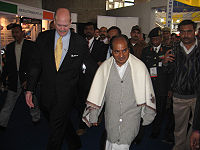 A.K. Antony the current Defence Minister of India is an atheist who was born to a Malayali family in the Alappuzha district of Kerala
A.K. Antony the current Defence Minister of India is an atheist who was born to a Malayali family in the Alappuzha district of Kerala
(Excluding the tribal population)[23]
Language No. of speakers % of population Malayalam 28,096,376 96.66 Tamil 616,010 2.12 Tulu 111,670 0.38 Kannada 75,571 0.26 Konkani 64,008 0.22 Telugu 47,216 0.16 Hindi 21,751 0.07 Urdu 12,625 0.04 Gujarati 6,369 0.02 English 3,002 0.01 Punjabi 2,201 0.008 Bengali 1,919 0.007 Nepali 1,312 0.005 Sindhi 1,185 0.004 Oriya 733 0.003 Dilli 277 0.001 Assamese 264 0.001 Arabic 243 0.001 Dogri 134 - Kashmiri 102 - Manipuri 81 - Kodagu 75 - Sanskrit 31 - Mizo 12 - Khasi 11 - Lahouli 11 - Bodo 7 - Santali 7 - Tripuri 5 - Bhotia 4 - Kukki 2 - Munda 2 - Ah 1 - Adi 1 - Kisan 1 - Kota 1 - Chakezang 1 - Kurukh 1 - Gondi 1 - Lanta 1 - Tibetan 1 - Other languages 4256 0.15 Total 29,067,481 100% Religion and Community
 Hindu women worship during Attukal Pongala at Tippu Street, South Fort, Thiruvananthapuram.
Hindu women worship during Attukal Pongala at Tippu Street, South Fort, Thiruvananthapuram.
According to the 2001 census[5] the breakdown of ethnic groups by religion is:
Malayalam Other languages Total Hindu 54.20% 2% 56.20% Muslim 23.70% 1% 24.70% Christian 18.00% 1% 19.00% Other religions <0.1% <0.1% 00.10% Total 96.00% 4.00% 100.00% The breakdown of Hindus by community is
Community Total Ezhavas 22.91% Nairs 14.41%[24] Pulaya 03.27%[25] Brahmins 01.59% Cheruman 00.99% Other Scheduled Castes 05.55% Hindu Tribals 01.07%[26] Others 08.00% 1968 Socio-Economic Survey of Kerala
In 1968, the Communist government under E. M. S. Namboodiripad ordered a massive and comprehensive socio-economic survey of each resident in the state of Kerala, to assess the social inequality for people belonging to different castes. This survey remains the only caste-count ever conducted in post-independent India till now. The survey found that individuals belonging to higher castes possessed more land and had relatively higher per capita income as compared to the general population. The survey found that only 33% of the states population is forward caste, almost half of whom where Syrian Christians.[27]
According to the survey, 13% of the Brahmins, 6.8% of the Syrian Catholics, 5.4% of the Jacobites and 4.7% of the Nairs owned more than 5 acres of land, while just 1.4% of the Ezhavas, 1.9% of the Muslims and 0.1% of the Scheduled Castes had that much land in their possession.[28]
Caste Population (1968) Percentage Brahmin 353,329 1.76% Nair 2,905,775 14.46% Nair Inferior 435,396 2.17% Kammalar 756,178 3.76% Vellalar / Chetty 151,150 0.75% Izhava / Nadar 4,457,808 22.19% Kaniyan / Arayan / Mukkuvan 851,603 4.24% Scheduled Castes 1,578,115 7.85% Ezhuthachan / Maravan 260,042 1.29% Syrian & Anglo - Indian 3,214,278 16.00% Latin Catholic 731,207 3.64% Christian Scheduled Caste 301,912 1.50% Muslim 3,842,322 19.12% Scheduled Tribe 253,519 1.26% Total 20,092,634 100.00% The Census of 1968 was not very conclusive, since the survey takers merged several unrelated castes in to one group (for example, Ambalavasis and Tamil Brahmins were grouped along with Malayali Brahmins). The last comprehensive caste census of Kerala was undertaken by the British in 1931 (the Census of 1941 also asked caste, but the tables were never published).[29]
Caste Population (1931) Percentage (1931) Malayali Brahmin 50,240 0.51% Foreign Brahmin 121,748 1.24% Ambalavasi Brahmin 39,371 0.40% Samanta Kshatriya 5,901 0.06% Samanthan Nair 4,921 0.05% Nair 1,505,929 15.30% Vilakkithala Nair 35,199 0.36% Veluthedath Nair 22,219 0.23% Kammalar 265,752 2.70% Vellalar 88,584 0.90% Chetty 49,213 0.50% Izhava + Thiyya 2,007,901 20.40% Kaniyar 39,371 0.40% Mukkuvar + Arayar 88,584 0.90% Parayar 165,656 1.68% Pulayar + Cherumar 678,387 6.89% Kuravan 95,295 0.97% Thandan 41,214 0.42% Nadar 402,555 4.09% Syrian Christian 1,197,553 12.17% Non-Syrian Christian 807,686 8.21% Muslim 1,604,629 16.30% Total 9,842,650 Notes
- ^ Śr̲īnāthan, Eṃ (2006). Kēraḷattile bhāṣakaḷ. Tiruvantapuraṃ: Antārāṣtr̲a Kēraḷapaṭhanakēndraṃ. ISBN 8187590114.
- ^ Maṇalil, Pōḷ (2006). Kēraḷattile bhāṣānyūnapakṣaṅṅaḷ : sāmūhika caritr̲aṃ. Kolzhikode: Mātr̥bhūmi Buks. ISBN 8182642264.
- ^ George, K.M (1972). Western influence on Malayalam language and literature. New Delhi: Sahitya Akademi. ISBN 8126004134.
- ^ "Spot the Mallu, anywhere". The Hindu Online. http://www.hinduonnet.com/thehindu/mp/2003/04/14/stories/2003041400210100.htm.
- ^ a b Linguistic minorities of Kerala
- ^ Kerala History Deepthi.com. Retrieved 10 March 2009.
- ^ Gantz Brothers, Land of the Perumals 1863
- ^ Menachery G. 1973, 1998; Vellian Jacob 2001; Weil, S. 1982; Podipara, Placid J. 1970
- ^ Bindu Malieckal (2005);
- ^ Thiru. Mu. Kovintācāriyar, Vāḻaiyaṭi vāḻai Lifco, Madras, 1978 at pp. 26-39.
- ^ "History of Kerala iyers and Agraharams". Kuzhalmanna Agraharam website. http://www.kuzhalmannamagraharam.info/articles/kerala-iyer-history.html. Retrieved 2008-08-27.
- ^ "Migration Theories". keralaiyers.com. http://www.keralaiyers.com/migration. Retrieved 2008-08-19.
- ^ Towards Modern Kerala, 10th Standard Text Book, Chapter 9. www.education.kerala.gov.in
- ^ Kerala History Udupi Madhwa Brahmana Sabha (Kerala). Retrieved 9 March 2009.
- ^ The History of Shivalli Brahmins Kakkilayas Of Bevinje. Retrieved 9 March 2009.
- ^ Languages Spoken by More Than 10 Million People. Encarta. Archived 2009-10-31.
- ^ "The Karnataka Official Language Act" (PDF). Official website of Department of Parliamentary Affairs and Legislation. Government of Karnataka. http://dpal.kar.nic.in/26%20of%201963%20(E).pdf. Retrieved 2007-06-29.
- ^ Kudva, Venkataraya Narayan (1972). History of the Dakshinatya Saraswats. Samyukta Gowda Saraswata Sabha.
- ^ arts, South Asian." Encyclopædia Britannica. Encyclopædia Britannica 2007 Ultimate Reference Suite.
- ^ It's Dandiya time again The Hindu. Retrieved 9 March 2009
- ^ The Advent of Gujrathi's in Kerala
- ^ "Students eager to master life skills". The Hindu. October 19, 2006. http://www.hindu.com/2006/10/19/stories/2006101900170200.htm. Retrieved 10-03-2009.
- ^ Keralathile Bhashakal (Languages of Kerala) By Dr. M. Sreenadhan. Published by International Centre for Kerala Studies, University of Kerala, Kariavattom, Thiruvananthapuram.
- ^ Socio-Economic Survey 1968 http://www.jstor.org/pss/4367366
- ^ http://censusindia.gov.in/Tables_Published/SCST/dh_sc_kerala.pdf
- ^ http://censusindia.gov.in/Tables_Published/SCST/dh_st_kerala.pdf
- ^ G.O.K 1971: Appendix XVIII
- ^ http://www.jstor.org/pss/4367366
- ^ Census 1931 of Travancore (Imper. Table XVII), Census 1931 of Cochin (Imper Table VXII) & Census 1931 of Madras Vol.2, p.306-310
Categories:- Kerala society
Wikimedia Foundation. 2010.


